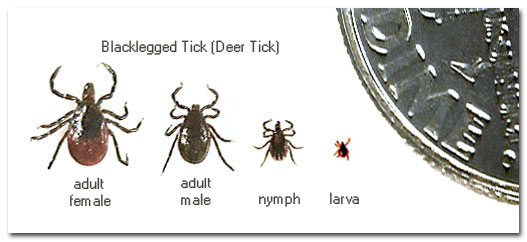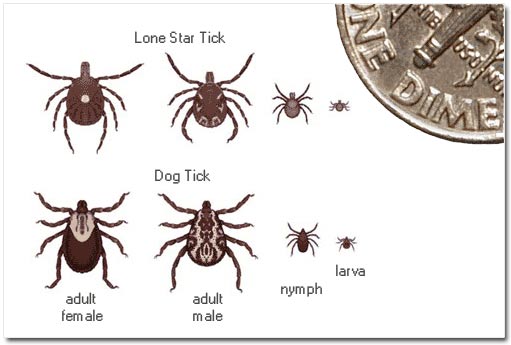Lyme Disease, page 1
Lyme Disease Transmission, Symptoms, Treatment, Prevention, Pulling Tick Out
TABLE of Contents:
- Lyme Disease Transmission
- Lyme Disease Symptoms and Diagnosis, Testing Ticks
- Lyme Disease Treatment
- Lyme Disease Prevention and Control
- If You Are Bitten By a Tick - What To Do
Lyme disease was first recognized in 1975 as a distinct clinical disorder and is currently the most frequently reported vector-borne disease in the United States (CDC 1995).
Lyme disease is caused by the bacterium Borrelia burgdorferi and is transmitted to humans by the bite of infected blacklegged ticks.
Typical symptoms include fever, headache, fatigue, and a characteristic skin rash called erythema migrans. If left untreated, infection can spread to joints, the heart, and the nervous system.
Lyme Disease Transmission
The Lyme disease bacterium, Borrelia burgdorferi, normally lives in mice, squirrels and other small animals. It is transmitted among these animals, and to humans, through the bites of blacklegged tick (or deer tick) - Ixodes scapularis (in the northeastern and north-central United States) or Ixodes pacificus (In the Pacific coastal United States). Blacklegged ticks can occasionally transmit other tick-borne diseases as well.

(Figure provided courtesy of the Division of Vector-Borne Infectious Diseases, Ft. Collins, CO)
Blacklegged ticks live for two years and have three feeding stages: larvae, nymph, and adult. The image below shows appearance and relative sizes of adult male and female, nymph and larval deer ticks, remember attached ticks will enlarge as they feed.

Other tick species found in the United States have not been shown to transmit Borrelia burgdorferi.

When a young tick feeds on an infected animal, the tick takes the bacterium into its body along with the blood meal. The bacterium then lives in the gut of the tick. If the tick feeds again, it can transmit the bacterium to its new host. Usually the new host is another small rodent, but sometimes the new host is a human. Most cases of human illness occur in the late spring and summer when the tiny nymphs are most active and human outdoor activity is greatest.
Although adult ticks often feed on deer, these animals do not become infected. Deer are nevertheless important in transporting ticks and maintaining tick populations.